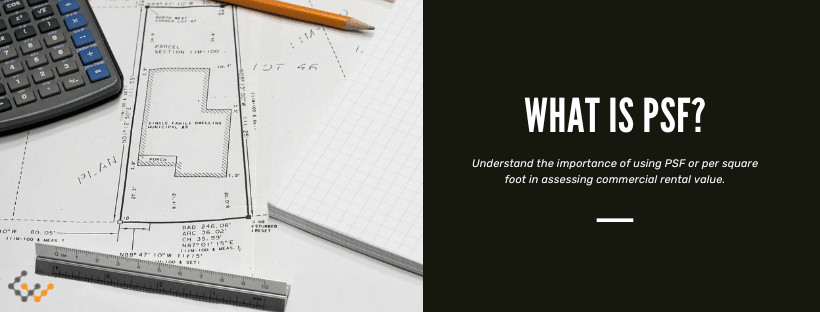What Does PSF Stand for in Real Estate?

What is PSF in real estate? Per square foot, often called just PSF in commercial real estate, is a very important term to understand when buying, leasing, or managing these properties. It is a method often used in calculating the real estate rental value and communicating the size and scope of a property for sales transactions. Understanding what it is and the PSF rate within a local area can be critical to making wise business decisions.
What is PSF In Commercial Real Estate?
In contrast to a residential rental agreement, in commercial rental spaces, the cost for renting is not just based on the number of units on the property but rather on the amount of space the contract or lease is for. Commercial real estate focuses on the “per square foot” of the space. For example, the rent listed may be at $20 PSF. It communicates the cost of renting each square foot of space each year.
For example, if a tenant pays $20 PSF for a property of 1,000 square feet, they are agreeing to a lease of $20,000 per year. Most often, this is still broken down into monthly payments, though.
Answer a few questions and get custom mortgage quotes. We'll match you with offers from our network of 650+ lenders.
How PSF Differences in Gross Leases and Net Leases
For property owners considering leasing agreements, knowing the difference between gross and net leases is important. This is a difference that can impact what is being paid for any property.
A net lease may also be referred to as an NNN lease. This type of lease is not uncommon, but it is likely to be more expensive to the tenant than what a PSF figure may suggest. Most of these leases are called triple net leases.
That means that the tenant pays three of the key costs for the property – the base rent as well as the property taxes on the building, the insurance on the property, and the maintenance costs associated with the property. That adds up over time.
By contrast, a gross lease does not have all of these figures. Rather, the gross lease communicates one price point. Then, the property owner or landlord pays the rest of the cost.
The landlord maintains the property, pays the taxes, and so on. This is the commercial setup in many residential rental agreements and applies to some commercial leases as well.
There are various forms of net leases. Most of the time, this type of lease is in place for properties with a single tenant. However, a multi-tenant property can still have a net lease.
In that situation, each of the tenants will have a proportional or pro rata share of the associated costs for maintaining the property. In this situation, the lease is likely to be called a modified gross lease. The tenant will take on a portion of the expenses to maintain the property but not all of them.
What Is the Asking Rents Per Square Foot On Average?
Like any other investment, costs will differ based on location and features. In most markets across the United States, the average price per square foot will range from as low as $8 up to $23 per square foot. Some cities may have a much higher cost, especially in areas where there are limited options in property available for rent due to low competition. Costs are typically lower where there is less demand for the property or it is less specialized to fit the needs of the tenant.
A good example of this is office space. Renting office space in New York City will likely cost much more than renting the same size and type of property in Detroit or Cleveland.
Another factor that influences the average PSF for commercial real estate is the functionality of that space. What does the property offer to the tenant? A community with dozens of available office spaces will have a much lower PSF than those with too few office spaces but too much warehousing space.
Industrial properties tend to have a lower overall PSF than office space, but that depends on location. For example, manufacturing properties and warehouses often have to be located in an area with good urban freeway access but cannot typically be located in the downtown or commercial sectors. Those areas – like the commercial districts in many communities – tend to have a much higher PSF. Also, these types of properties tend to be less expensive to build, reducing the overall cost they demand.
It is possible to use PSF for many factors, with the goal of better understanding how two properties compare to each other. This can play a role in the overall decision an investor makes when looking at both the average cost as well as the use of the property.
For example, if an investor is considering the purchase of two separate office spaces or a tenant is considering renting two locations, comparing PSF provides an opportunity for insight into which could be the best overall choice.
The same applies to other forms of commercial real estate. It is not uncommon to see PSF used to describe the values of various residential rental properties. This is especially true in duplex scenarios.
How to Calculate PSF In Commercial Real Estate
The calculation of PSF in commercial real estate refers specifically to the number of square feet of operating space the tenant offers. For example, the price is typically a set dollar amount per square foot of space.
If a property has a PSF of $15, that means that the cost to rent each square foot of the space will be $15. If that property has 2,000 square feet, the cost would be $30,000 for the year. That is:
- Cost per square foot (15) times the number of rented square feet (2000) equals the annual cost, or $30,000.
Typically, then, the property will have a lease drawn up with monthly payments. The total annual cost is divided by 12 to get this figure. In this case, the cost would be $30,000 divided by 12, or $2,500 per month.
Additional costs may apply in some areas. Taxes may also not be included in some situations.
Benefits to Commercial Real Estate PSF
It is quite common to see PSF listed in commercial real estate. By calculating this figure, it is typically easier for investors and tenants to compare two different commercial properties to each other to determine which offers the features and costs needed based on the amount of available space. It also enables for better comparison of rental rates in one area to the next, which can prove to be critical when a company is trying to decide where to invest.
Wrapping Things Up
The per square foot, or PSF, of any commercial real estate rental opportunity, is a clear indication of the property’s cost to rent based on the size of the space. This is a commonly used tool in determining the cost of one property as compared to another and can be used by both tenants and property owners or investors to determine the value of any relationship. A simple calculation, PSF is often a very accurate tool for estimating value and cost in any situation.

